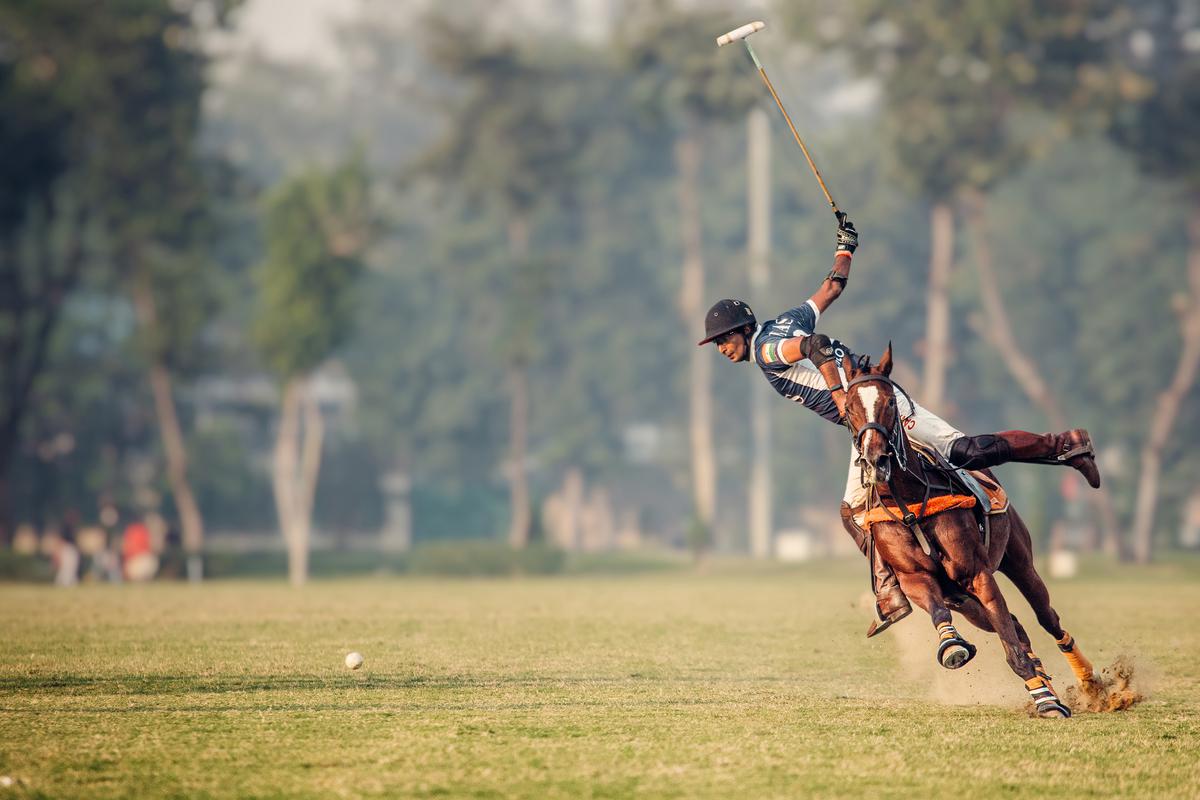In Shandur, Pakistan, home to the world’s highest polo field in the shadow of the snow-dusted Karakoram mountains is a plaque that reads “Let other people play at other things, the king of games is still the game of kings”.
The words found an echo on a dark afternoon in Jaipur’s Rajasthan Polo Club (RPC) grounds recently when, despite slanting drops of rain slamming the sodden earth, players wielded mallets like sabres as they cannoned the ball towards the goals, drawing cheers from those in the stands.
Sawai Padmanabh Singh takes a swing with his mallet at the Rajasthan Polo Club, Jaipur
| Photo Credit: Special arrangement
The Leela Palaces, Hotels and Resorts had partnered with RPC for its inaugural sponsorship of The Leela Maharaja Sawai Man Singh Polo Cup 2022. The Leela Polo Team was captained by Sawai Padmanabh Singh, the titular maharaja of Jaipur, while Chandna Carysil had among its players, Ashok Chandna, Rajasthan’s Minister for Youth Affairs and Sports. The match, a magnificent display of man and beast, ended in a 2-2 draw.
Reviving the Olympic sport
Padmanabh Singh, 24, who led the Indian polo team at the World Cup play-offs in South Africa in September, says, “Despite the precarious conditions on the ground we are glad to have played.” Fondly called Pacho by those closest to him, he started playing polo at 12. “At Dussehra, we do aswa pujan following a tradition of worshipping the horse,” says Padmanabh, who played his first international tournament in the Black Forest, Germany, swinging a made-in-Argentina mallet. “Although my great-grandfather Sawai Man Singh, my grandfather and my father played the sport, it was only at Mayo College that I discovered it for myself.”
Sawai Padmanabh Singh, titular maharaja of Jaipur, at The Leela Maharaja Sawai Man Singh Polo Cup tournament
| Photo Credit: Special arrangement
Mayo College, in Ajmer, has been a nurturing ground for polo players, especially from princely families, who have been patrons of the sport in pre-Independence years. Indian royals found in polo, both heroism and horsemanship, qualities they revered and soon the sunburnt plains of North India echoed to the sound of hoofbeats, the whack of mallet on ball and a refined culture that grew around the game.
Legend has it that polo originated in Central Asia when Genghis Khan played with the decapitated heads of his opponents. The former Olympic sport was revived in the 19th Century when a British subaltern learnt the game in Manipur and popularised it among tea planters in Assam and cavalry units in the Army. When it travelled outside the subcontinent via the Raj – nearly 100 countries play polo today – it became the royalty-patronised, champagne-drinking, divot-stamping, fashion-conscious sport that it is today.
In post-1947 India upto the early Noughties, it has been the Army that has largely held the sceptre for polo. Colonel Ravi Rathore, ex-commandant of 61st Cavalry (raised in 1953 as the last, operational unmechanised horse-mounted cavalry unit in the world to serve as a bridge between cavalry units of the past and armoured units of the present at Pt Nehru’s insistence) and an Arjuna awardee, is the only Indian to have played in five consecutive world cups from 2003 to 2017.
“I got a headstart at polo when I learnt to ride at seven, thanks to my Army-officer father. At 14, I played my first tournament, the Junior Nationals in Delhi. The first chukker of my life was on 18-year-old horse, Your Honour. It was a triumph of sorts as I was a child on a seasoned pony. I went on to become the youngest in the history of the National Defence Academy to have a +2 handicap,” says Rathore, adding that role of the horse changed with the mechanisation of cavalry units in 1938.
Bringing in visibility
Alwar, Bharatpur, Jaipur, Jodhpur and Patiala continued to produce prime polo players. Today, the Army draws its horses from the Remount Depot in Saharanpur. “You are assigned a horse when it’s around five-years-old and the onus is on you to train it for what it is best at – polo, eventing, dressage or show-jumping. In my 21 years with the unit I’d pick two favourites: Picture Perfect, a black horse with a white face, and Buggy from New Zealand.”
While infrastructure for the 61st Cavalry at the time of raising came from the Jaipur royals, the Army grounds in Delhi, Jaipur, Mumbai, Bengaluru and Hyderabad gave access to many budding polo players. “The Army offers classes at a subsidised fee,” says Rathore over a phone call from Singapore where he now lives, “although more clubs and the Arena polo league need to be set up to bring in more players. Money is not the challenge, it needs to be marketed.”
The game
Polo is played on horseback by two opposing teams with four riders each. Matches usually last an hour and are divided into chukkers or periods of play, each lasting seven-and-a-half minutes when ponies are changed. The objective is to hit a small hard ball, earlier made of willow root and now of plastic, into the opposing team’s goal using a long handled wooden mallet.
The modern game of polo is derived from Manipur where it is known as sagol kangjei.
Players are rated on a scale from -2 to 10, -2 indicating a novice player. This is the handicap system created at the founding of the USPA so that teams can have equal skillsets when using players with varying abilities. The Number 3 player is usually the tactical leader wielding the highest handicap.
Polo ponies are full-grown horses drawn from Manipur (the breed is fading), Arabians and thoroughbreds. Criollo horses from Argentina have gained popularity over the years. Warm-blood breeds from Europe cost upwards of ₹40 lakh.
The Kolanka Cup, the world’s tallest sport trophy, is a six-foot tall silver cup. It is believed that it can hold more than 27 bottles of champagne.
The 61st Cavalry has 12 Arjuna awardees.
“To make polo acceptable, it needs to be made visible as a high adrenaline sport and accessible to those keen on it,” says Major Adhiraj Singh (retired), 60, a polo patron who played for the Leela team and is the oldest competitive polo player in India. An Arjuna awardee, he has been playing since his teens, spurred by a family where both uncles and his brother are Arjuna awardees.
“Infrastructure is a huge investment in polo. Cricket can be played on a ground or a street but for polo you need acreage, stables, horses costing lakhs, especially the best imported from Argentina. Despite safeguards, it remains a dangerous sport; the chances of injury are high. Unless you stop worrying about children getting hurt we are not going to find young riders to nurture. Which is why most players come from the Army because there is an inherent sense of adventure in an armyman,” says Adhiraj, adding that Jaipur could evolve as a polo hub given that Padmanabh Singh still has his best years ahead of him and will continue to inspire younger riders.
(From left) Sawai Padmanabh Singh, Major Adhiraj Singh (retired), Evan Power, Louis Ronksley and Abhimanyu Pathak of the Leela Team. To commemorate the tournament The Leela Palace Jaipur hosted a royal soiree and champagne afternoon tea.
| Photo Credit: Special arrangement
The woman’s swing
There is a growing legion of women in the sport, many now trying to play alongside seasoned men players. In Manipur, women’s teams regularly bump-off with women’s teams from the US Polo Association, but most riders are concentrated in Delhi and Mumbai.
Avshreya Pratap Singh Rudy, 30, an advocate at the Delhi High Court, began riding at four. From the Delhi Riding Club she went on to ride at Mayo but stopped briefly when in Law school. “When I returned to Delhi, I got back on the saddle at the Rajputana Rifles Regimental Centre. Here, I learnt to play stick and ball and graduated to playing polo with the jawans on a tough sandy patch. It taught me to be rough and ready, how to stay on a galloping horse, hold the reins and whip in one hand, balance the mallet in the other and keep my head at that speed.”
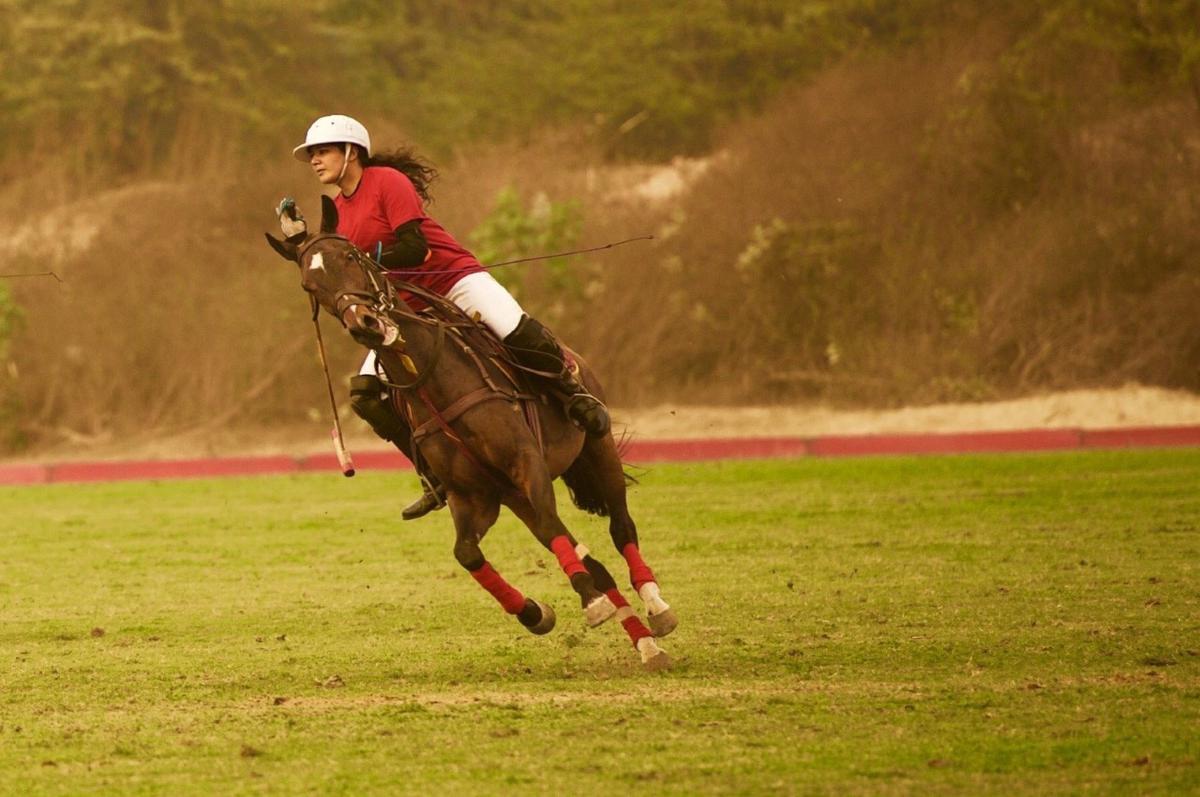
Avshreya Pratap Singh Rudy
| Photo Credit: Special arrangement
She adds, “The jawans taught me how to hit unhindered by the gear – the helmet, the knee and elbow guards. There’s so much going on that riding becomes muscle memory. A year later I was bruised but toughened and confident and thought I should give a match a shot although many seasoned players believed that a woman’s swing cannot carry the ball too far. It started with a few chukkers, some exhibition matches, women’s matches… it is empowering as it’s among the few sports in the world where men and women compete as equals. There was no looking back… I rode in the mornings, played chukkers in the afternoon and went on to play in Delhi and Jaipur at mid-level tournaments. Most women have a handicap of -2 to 0. Unless women’s matches have the same traction as the men’s they don’t draw sizeable crowds, unless its in Rajasthan where people know the rules, and livelihoods stem from the game.”
Style file
Women bring their fashion to the game although technicalities take precedence for safety. “Breeches have to be white. Black and tan leather boots with spurs may be customised but need to have good grip and with a strap over the zip there is the danger of getting stuck in the stirrup; though now we have detachable stirrups in case the horse bucks and you are dragged along. Women wear scarves in team colours and companies like Casablanca customise helmets but the bottomline is to have something not too constricting. Good helmets cost upwards of ₹50,000. Mallets, saddle cloth and putties for horses can be customised” says Avshreya Pratap Singh Rudy.
The Chennai story
With the 1892-established Indian Polo Association, the governing body for the game in India, headquartered in Delhi and polo season beginning in October at the cusp of autumn and winter, most tournaments are held in Delhi, Jaipur, Jodhpur, Mumbai and Hyderabad. But not too long ago, the season began in September in Chennai.
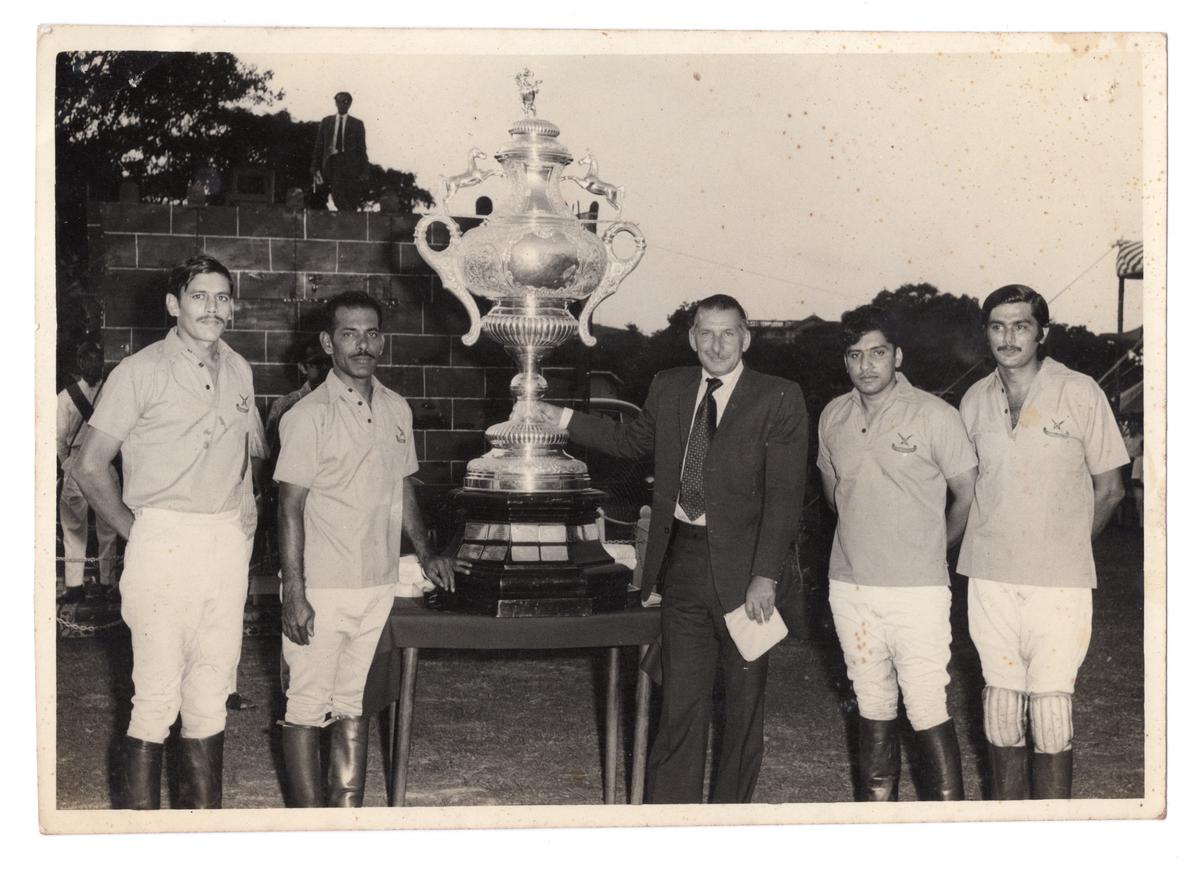
Kishore Futnani (first from the right) with Field Marshal Sam Manekshaw and the six-foot tall Kolanka cup
| Photo Credit: Special arrangement
Kishore Futnani, 72, who has pursued and promoted equestrian sports for more than 60 years, played polo in the 1970s and ‘80s and still rides every day guiding young riders in show jumping and dressage at the Chennai Equitation Centre, Shollinganallur. “At that time the Madras Polo and Riders Club was a well-known institution and industrialists such as MAM Ramaswamy and AC Muthiah being players of repute took an active part in promoting the sport. Muthiah brought in one of the world’s finest players, Maharaj Prem Singh to train aspiring players. MV Prakash, a polo player, was the backbone of organising the tournaments in Madras, sometimes sponsored by the ITC,” he says, adding, “since the Race Club subsidised the riding clubs the sport was affordable.”
The sport that drew teams to Chennai from across Army units, and civilian players from Mumbai, Kolkata, Australia, Singapore, Malaysia and England, slowly faded out as the city’s polo grounds became inaccessible or changed nomenclature. “Madras had four polo grounds then – two at the Officers Training Academy, one inside Raj Bhavan and one in Kotturpuram,” says Kishore. “Matches were held here with well-known players such as Brigadier VP Singh, the Sodhi brothers – Billy and Pickles, and Colonels Kuldeep Garcha and Pradeep Mehra.”
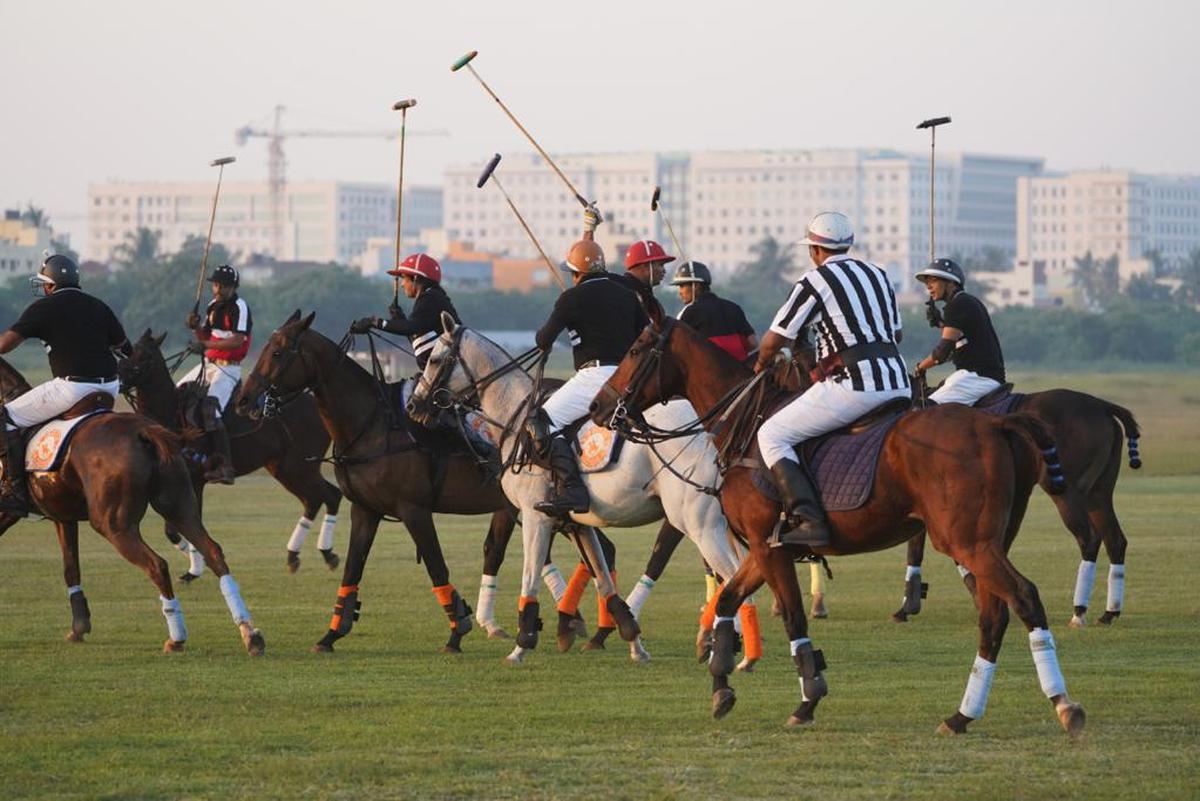
Polo players in Chennai
| Photo Credit: Special arrangement
Kishore adds that the sport is witnessing a revival of sorts at the Polo 2.0 Chennai grounds at Senneerkuppam on the outskirts of the city.
NV Ravi, a Chennai-based architect, says the team at Polo 2.0 that includes Irshad Mecca and Saleem Mohammad, occasionally plays at OTA and has a chukker or two to celebrate birthdays and Republic Day. “We invite friends to come and watch us play. We hope they take our enthusiasm forward. Polo needs the kind of push that chess got from the State,” he says, “we have the team but we need the support. Equestrian sport is not as unaffordable as it is made out to be and people are keen to try something new. You just need the passion for it.”
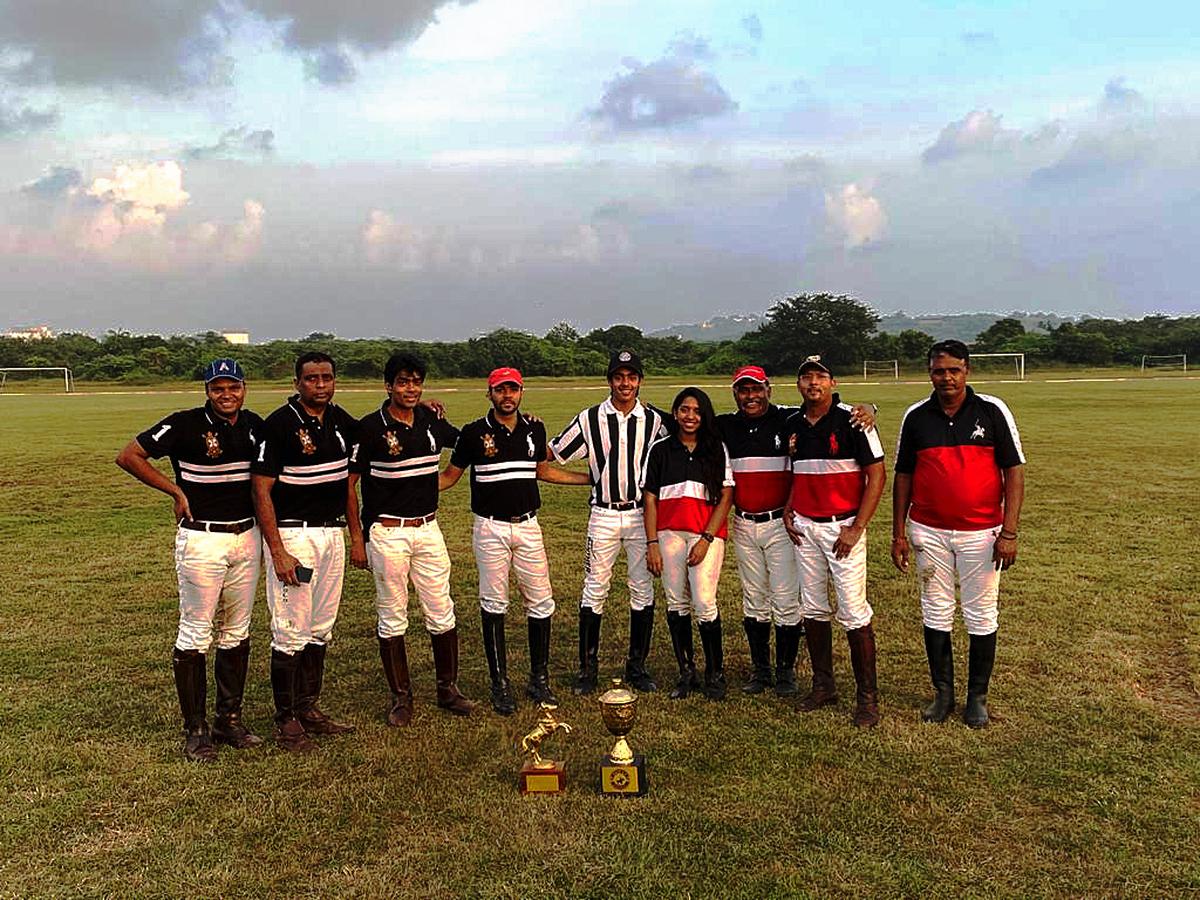
NV Ravi is third from right
| Photo Credit: Special arrangement
Kishore adds, “You need to be a good horseman, have access to ponies that are trained for the purpose – agile, quick to race and quick to stop. And practice. Some like the maharaja of Alwar turned up at 6am for practice even if they had spent the night partying.”
“Beyond the sport’s flamboyance, you need to saddle up every day to have a longer span as a player,” says Rathore. “Only a disciplined horse and rider will last the course.”


